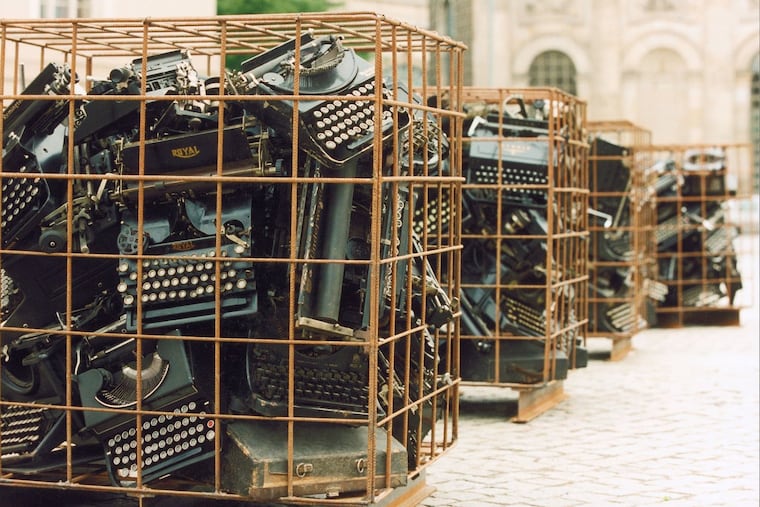The UArts closure sent this renowned art exhibit into storage. Where will it go next?
UArts School of Art Dean Sheryl Oring was left with days to relocate the dozens of heavy typewriters that make up her renowned exhibit, Writer's Block. Now a Philly business could be their next home.

When Philly’s University of the Arts announced its closure with only a week’s notice, employees were left scrambling. Across campus, staff emptied their classrooms and workspaces, hauling off cellos and ceramics en masse. But perhaps the heaviest relocation was tasked to School of Art dean Sheryl Oring, who had to relocate her 150 manual typewriters into a storage unit.
Now, the educator is hoping the typewriters’ next home will be a public space in the city.
Combined, the machines make up “Writer’s Block” — a renowned exhibit that has been displayed at New York’s Bryant Park, the Boston Public Library, Berlin’s Jewish Museum, and more. The exhibit comprises 18 rusted crates, each holding about 10 stacked typewriters. Writer’s Block was created by Oring in 1999 in Berlin, in observance of the anniversary of the 1933 Nazi book-burning.
The dozens of 1920s and 1930s typewriters Oring collected are “caged,” symbolic of the censorship that took place in Nazi Germany.
Most recently, the project was being housed at UArts. It’s one of several projects the artist and former reporter has done surrounding typewriters and freedom of speech. Her ongoing project, “I Wish to Say,” invites participants to dictate postcards to the president of the United States typed on a collection of Royal Quiet DeLuxe typewriters.
But the school’s shuttering prompted Oring to think on her feet.
With the help of Philly Typewriter, the nation’s largest typewriter repair shop and a longtime partner of Oring’s, the dean dismantled the exhibit and moved the dozens of heavy, yet delicate, typewriters into her car and friends’ cars over several days. Oring also gifted several typewriters to friends and former students.
By the numbers
Incorporating typewriters into art isn’t for lightweights. Here’s a look at the numbers.
18 sculptural crates: About 3 cubic feet and 700 pounds when fully assembled, filled with about 10 typewriters each
150 manual typewriters each weighing about 20 pounds
1 storage unit filled with typewriters: Over $500 per month
For now, the typewriters are biding their time inside a storage facility near the Navy Yard, Oring says. The facility costs the now-unemployed Oring “over $500 a month.”
That’s where Oring says the good people of Philadelphia come in. She’s hoping to find the exhibit — or the machines — a new public space.
» READ MORE: Tom Hanks gifted this Philadelphia shop a typewriter from his personal collection
“These sculptures have such an amazing history that feels just as relevant today as when I first made them in 1999,” she said. “I really hope I can get them out of storage and into a place [where] they can be viewed by the public. It’s amazing to watch people’s reactions whenever they’re on display and I’d love to share this work with the people in Philadelphia.”
The goal, Oring says, would be for “Writer’s Block” to find a new home in one new place, preferably indoors. Bill Rhoda, who co-owns Philly Typewriter, says the crates of typewriters could be easily transported with a pallet jack.
There’s also a willingness to divide the pieces around the city if needed.
“But keeping them accessible is paramount,” Rhoda said. “If someone, a business, a museum, a public access environment wanted to rent them, that’d be amazing, but even just finding these pieces a home is a priority.”
Rhoda added, “The history attached to ‘Writer’s Block’ has been experienced from Germany to New York and has impacted the world. These pieces cannot languish, and are in dire need of finding a home in the city of Philadelphia.”